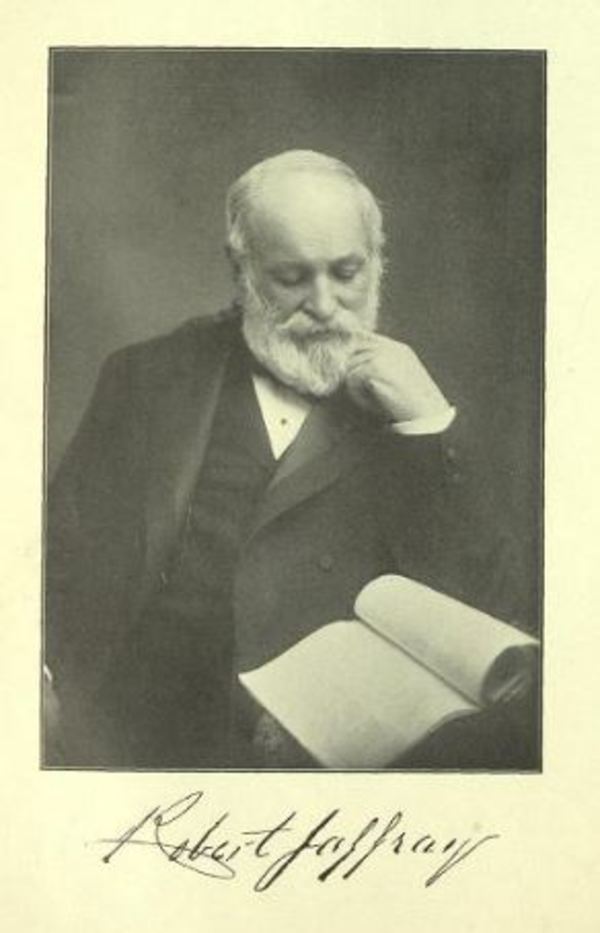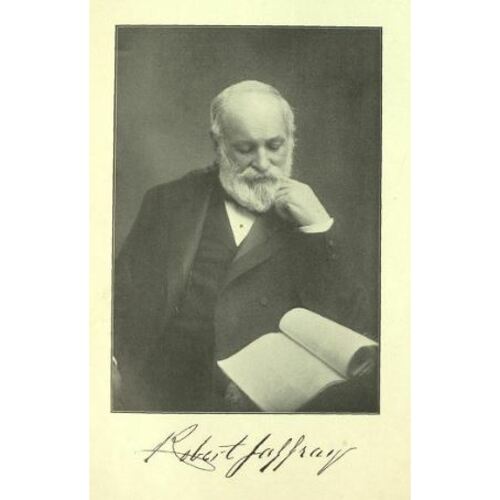
Source: Link
JAFFRAY, ROBERT, businessman, publisher, and politician; b. 23 Jan. 1832 on Skeoch Farm near Bannockburn, Scotland, second son of William Jaffray and Margaret Heugh; m. 22 Nov. 1860 Sarah Bugg (d. 1906) in Toronto, and they had two sons and two daughters; d. there 16 Dec. 1914.
Robert Jaffray went to school in Bannockburn. At 12 he lost his father, a nail manufacturer turned farmer, in a stagecoach accident. He attended the academy at nearby Stirling until age 15, when he was apprenticed to an Edinburgh grocer and wine merchant. In autumn 1852 he came to Toronto to manage the grocery and wine shop of his brother-in-law, John B. Smith. He had become a partner by 1857. Smith retired after fire destroyed his lumberyard and sash and door factory in 1858, leaving Jaffray as sole owner.
Within weeks of his arrival in Canada, Jaffray had become active in Reform politics; by 1857 he was a campaign worker in Toronto for George Brown*, an mla and the owner-publisher of the Globe. In 1874–77 Jaffray held an appointment from Liberal prime minister Alexander Mackenzie* as government director on the board of the Northern Railway, which had drawn heavily on federal funds during the previous Conservative administration. In 1879 he was the target of a bizarre kidnapping. Taken to a spot east of Toronto where he was to be imprisoned, he overpowered his captors and escaped. Police uncovered evidence suggesting the abductors were part of a plot to kidnap leading Liberals, but it remained unclear whether the primary motivation was money or political mischief.
When Brown was convalescing in 1880 from a gunshot wound, he gave his friend Jaffray a directorship in the Globe Printing Company. In 1882, two years after Brown’s unexpected death and the appointment of his brother, John Gordon, as managing editor, Donald Alexander Smith undertook to purchase control of Globe Printing, apparently to silence the daily’s criticisms of the Canadian Pacific Railway, of which he was a major backer. Brown’s widow, Anne, and her brothers Thomas and William Nelson alerted Jaffray and other leading Liberals, and offered to sell a controlling stake to the Reform party. Jaffray and financier George Albertus Cox bought about half of Anne’s shares; other party faithfuls took up the remainder. In December the new owners forced out Gordon Brown after learning that his inadequate financial controls had left the Globe in much greater debt than had been reported. The ouster also placated leading Ontario Liberals, who regarded Brown’s politics as anachronistic and harmful to party unity. Over the next few years Jaffray would acquire additional Globe shares from the Nelsons, who had taken them as collateral for loans to George Brown. Jaffray controlled the paper by 1888, when he became its president.
Jaffray’s initial investment was likely linked to the sale by April 1883 of his wholesale and retail grocery business to his brother George and James Ryan. Both moves were part of a broadening of his business interests that had begun in the 1870s. Though his success as a grocer had provided him with modest capital, it was largely political connections that brought him wealth and an entrée to Toronto’s business élite. In 1874, with British backing, he had helped establish the Toronto House Building Association (later the Land Security Company), which developed properties in the west end. A member of the Board of Trade from 1876, Jaffray became, along with Cox, a director of and investor in the Midland Railway, and he was vice-president of the Crow’s Nest Pass Coal Company Limited, which he and Cox founded in 1897. In 1885 he had been made a director of the Imperial Bank of Canada, of which he would become president in November 1914, and about 1886 he assumed the presidency of the Toronto Real Estate Investment Company. His many other directorships, often in association with Cox, included Toronto General Trusts, Canada Life Assurance, Canadian General Electric, and Central Canada Loan and Savings.
Jaffray’s heart, however, was in the Globe, where he continued the improvements in quality that had marked the Brown era. The paper added a four-page illustrated section in May 1889; it became the first Canadian daily to publish a half-tone photoengraving, in March 1891; and it installed a Linotype in April 1892, shortly after the technology had arrived in Canada. He stood by John Stephen Willison*, who, on his appointment as editor in 1890, insisted the Globe carry, for the first time, reports of Conservative meetings and speeches, much to the chagrin of Liberal leaders. Jaffray also supported his editor when Willison broke with party policy on several key issues. Willison’s successor in 1902, James Alexander Macdonald*, would enjoy the same independence.
Jaffray shepherded the paper through a period of falling circulation and a fire in 1895 that forced a complete rebuilding. He personally searched the charred remains to retrieve the paper’s invaluable subscription lists, found undamaged in a vault. By 1900 the Globe had rebounded, aided by printing and advertising contracts from the federal Liberal government elected in 1896. Dividends, suspended in 1880, were restored in 1897; daily circulation hit 44,000 in 1901, up about 20,000 over the decade.
A staunch party loyalist, Jaffray served as a vice-president and as president of the Toronto Reform Association during the early 1890s. In 1904 Ontario’s Liberal government, under George William Ross, appointed him chairman of the Temiskaming and Northern Ontario Railway Commission. He resigned after the Liberals’ defeat the following year, but on 8 March 1906 he received a Senate appointment as a reward for his lifelong service to the party. The honour was not without irony, since under Jaffray the Globe had slipped the bonds of party subservience and had become much more politically independent. Such separation, however, was not always as evident in Jaffray’s business interests. Willison felt he had been tricked into an editorial position favouring the Crow’s Nest Pass Coal Company in 1897. On the other hand, Jaffray resigned as a director of the Toronto Electric Light Company to avoid a conflict of interest with the Globe’s support of publicly owned power in Ontario.
Jaffray died in 1914 from an aneurysm and was buried in Mount Pleasant Cemetery after a Presbyterian service at Surrey Lodge, his home on Grenville Street. His elder son, William Gladstone, became president of the Globe. It remained in family hands until 1936, when it was sold to mining magnate William Henry Wright* for $1.3 million and soon merged with the Mail and Empire.
AO, F 1075, MU 1290, box 2, file 10; RG 22-305, no.30343; RG 55-17-63, no.2928; RG 80-27-2, 66: 94. MTRL, SC, Toronto scrapbooks, vols.3, 5. Globe, 1879–1901, 8 March 1906, 17 Dec. 1914. Canadian album (Cochrane and Hopkins), 1: 153. Canadian men and women of the time (Morgan; 1898 and 1912). H. [W.] Charlesworth, More candid chronicles: further leaver from the note book of a Canadian journalist (Toronto, 1928). A. H. U. Colquhoun, Press, politics and people: the life and letters of Sir John Willison, journalist and correspondent of the “Times” (Toronto, 1935). Commemorative biographical record of the county of York . . . (Toronto, 1907). Cyclopædia of Canadian biog. (Rose and Charlesworth), vol.2. Dict. of Toronto printers (Hulse). Directory, Toronto, 1883–93. History of Toronto and county of York, Ontario . . . (2v., Toronto, 1885), 2. W. H. Kesterton, A history of journalism in Canada (Toronto, 1967). Allan Levine, Scrum wars: the prime ministers and the media (Toronto, 1993). W. T. R. Preston, The life and times of Lord Strathcona (Toronto, [1914?]); My generation of politics and politicians (Toronto, 1927). Paul Rutherford, A Victorian authority: the daily press in late nineteenth-century Canada (Toronto, 1982). Joseph Schull, Edward Blake: leader and exile (1881–1912) (Toronto, 1976). Toronto, Board of Trade, “A souvenir”: a history of the growth of the Queen City and its board of trade . . . (Montreal and Toronto, 1893). J. [S.] Willison, Reminiscences, political and personal (Toronto, 1919).
Cite This Article
Dean Beeby, “JAFFRAY, ROBERT,” in Dictionary of Canadian Biography, vol. 14, University of Toronto/Université Laval, 2003–, accessed January 6, 2026, https://www.biographi.ca/en/bio/jaffray_robert_14E.html.
The citation above shows the format for footnotes and endnotes according to the Chicago manual of style (16th edition). Information to be used in other citation formats:
| Permalink: | https://www.biographi.ca/en/bio/jaffray_robert_14E.html |
| Author of Article: | Dean Beeby |
| Title of Article: | JAFFRAY, ROBERT |
| Publication Name: | Dictionary of Canadian Biography, vol. 14 |
| Publisher: | University of Toronto/Université Laval |
| Year of publication: | 1998 |
| Year of revision: | 1998 |
| Access Date: | January 6, 2026 |



